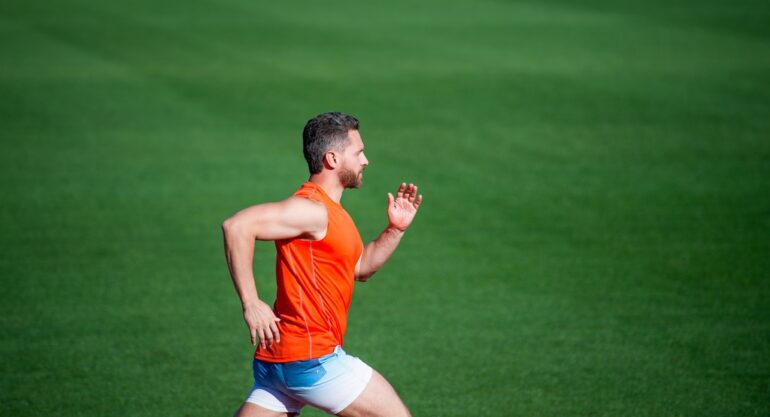10k in miles is 6.2 miles – that’s the quick answer. But if you’re training for a 10k race, there are a few other things you need to consider.
A 10k race is a stepping stone for the marathon and ultramarathon races. It’s also an exciting experience in itself, challenging you but not requiring as much training as longer races.
Whether you’re new to running or have already completed some 5k runs, running a 10k is unforgettable.
In This Article:
How Many Miles Is a 10k?
The “k” in 10k refers to kilometers. Doing the kph to mph conversion, 1 kilometer is roughly 0.6 miles, so 10k in miles amounts to around 6.2 miles or a half marathon. For comparison, a 5k in miles is half that distance or 3.1 miles.
So, what’s a 10k race like? It’s one of the most popular long-distance running events. It’s a great challenge for beginner runners while also appealing to seasoned ones.
On a running track, a mile is 4 laps, which adds up to 25 laps for a 10k run. If a 10k race sounds a bit daunting, remember that a marathon is 26.2 miles. A 10k sounds like a breeze, by comparison, doesn’t it?
How Long to Prepare for Your First 10K Race
If you’re a beginner runner, going from couch to 10k is going to take you 8 to 10 weeks. In some cases, you can accelerate training and take 4 weeks or even less to get in shape for the race.
Preparing for your 10k race means challenging yourself, but you don’t have to aim for breaking the world record for one mile.
Fun fact: The world record for one mile is 3:43.13 for men, set by Moroccan runner Hicham El Guerrouj in 1999, and 4:12.33 for women, set by Dutch runner Sifan Hassan in 2019.
Think more of a pace that comes close to the average marathon time, which falls somewhere in between 5 to 6.5 hours.
Average 10k Time for Beginners
The average for beginners running the 10k depends on many factors, including age, sex, fitness level, and whether you have any injuries such as runner’s knee, plantar fasciitis, or shin splints.
If you’re wondering how long it takes to run a mile in a 10k race, 9 to 14 minutes is a good start for beginner runners. A finish in between 50 to 70 minutes is not bad at all. It’s important to factor in the running surface, too.
Running a 10k on a hilly or trail course will challenge you more. It can push your finish time over 1 hour. By contrast, running it on a flat course can help you knock a few minutes off your finish time.
Average for beginners by age and sex
According to The State of Running 2019, an analysis carried out by RunRepeat and the IAAF on recreational runners, the average 10k finish time for males in good running shape was as following:
- Age: 16–19 – Time: 46:36
- Age: 20–24 – Time: 51:40
- Age: 25–29 – Time: 53:31
- Age: 30–34 – Time: 54:21
- Age: 35–39 – Time: 54:21
- Age: 40–44 – Time: 53:31
For females, the average 10k time was:
- Age: 16–19 – Time: 01:00:21
- Age: 20–24 – Time: 59:50
- Age: 25–29 – Time: 01:02:25
- Age: 30–34 – Time: 01:02:31
- Age: 35–39 – Time: 01:02:19
- Age: 40–44 – Time: 01:02:37
So what 10k finishing time should you aim for?
You want to challenge yourself, but you don’t want to overtrain and cause an injury. Fast runners are not made overnight – it takes years of running.
Aim for a finish between 50 to 70 minutes, which should provide the right mix of challenge and satisfaction while running. That means a 10-minute mile pace.
The University of Washington provides an easy-to-use pace calculator that lets you enter your average mile time to find out the average pace you need for a 10k race.
You can also check out the 10K race pace chart provided by the University of Northern Colorado to figure out your ideal running pace.
10K Training Plan for Beginners
If you want to go from couch to 10k, you’re probably wondering how many miles per week you should run. Or how often you should run to set a 10k personal record.
You want to begin with the right training plan for your fitness level, running experience, and time available for training. Your options include:
- Eight-week 10k training plans
- Four-week 10k training plans
- Two-week 10k training plans
Tip: Get a personalized 10k training plan to maximize results.
Now let’s take a closer look at some of the most effective running workouts for 10k races.
Performing drills
Training for a 10k isn’t only about clocking up miles. You want to incorporate into your running workouts speed drills to become faster. Running uphill is great too.
Work on your stride by aiming to increase the number of steps you get down on a minute – track these using a fitness bracelet or app.
Don’t forget to add in some dynamic stretching before running like high kicks or lunges to prevent injury.
Speed work and interval running
Interval runs combining jogging with running boost your cardiovascular health while requiring less time than distance running.
They’re a great way to up the intensity of your workouts while improving your sprinting and burning more fat for energy.
Running at threshold pace
At your threshold pace, lactate doesn’t build up in your blood, reducing fatigue and helping you run faster for longer. The threshold pace is about 75–80% of your max heart rate or a pace you can keep up for 50–60 minutes.
Long runs
Long runs are an integral component of your 10k training. You need to build up your endurance, and long runs are a great way to do it. Ideally, you want to aim for 8–10 miles for your long runs up until two weeks before the event or according to your running plan. During them, practice your goal race pace.
Strength training
Don’t leave strength training out of your plan. When you’re not running, you can go swimming, biking, or do yoga.
Cross-training and any form of endurance training will also help. You want to work your glutes or hips, hamstrings, quadriceps, and calves.
Rest day
Rest days are crucial to build endurance and speed and become a better runner. And the success of your rest days depends a lot on the quality of your sleep. Avoid distractions and screens at night, eat a light dinner, and try to sleep well.
10K Running Tips for Beginners
To complete your first 10k race with a good time, aim to raise your overall fitness level. Here are the key things you need to pay attention to.
Eat a healthy diet
What do pro runners eat? It’s definitely not highly processed foods. Think whole grains, lean protein, and plenty of fruit and veggies.
Oatmeal, peanut butter, Greek yogurt, sweet potatoes, and dark chocolate are just some foods you can add to your runner’s diet – and they are delicious! But even with these, you don’t want to overeat.
Work on your running form
Maintain a good posture. You want to run tall, engaging your core and gazing forward. Pay attention to your arm swing – it should be relaxed, with the hands loose.
Avoid hitting the ground with your heel as this may increase your injury risk. Aim to strike the ground midfoot instead.
Train consistently
Consistent training is what often makes the difference between runners who finish a 10k and those who dream of finishing it. Don’t skip on training unless you’re injured. Follow your running plan.
Recover well
Running injuries are common. Listen to your body, and don’t downplay the early signs of an injury. Recovery is as important as training – it’s what makes training possible in the first place. Most of all, know your limits.
Keep yourself motivated
To keep yourself motivated, you want to have fun even as you challenge yourself. Setting goals that are within your reach is crucial. Running with friends or joining an online running community can also help.
10k Race Day Tips for Beginners
Training is crucial, but there are a couple of other things you need to pay attention to.
Finding a 10K race
If you’re like many runners, you may not know the exact 10k race you’ll run when you start training. You can find races online using Road Race Runner or RunSignup.
Tip: The most popular 10k race isn’t necessarily the right one for you if it involves too much traveling or stress. A race closer to home may turn out to be more memorable.
Signing up early
Signing up early ensures you won’t avoid missing the race because of too many participants. You’ll also be able to set your training goals in time and pick the right training plan for you.
What should you eat the night before a 10k?
A big, hearty meal may seem the best idea to fuel your body for the race. But it’s better to increase your carb intake 2–3 days before the event to avoid stomach problems and feeling stuffed.
Go for healthy carbs like whole grains, quinoa, and sweet potatoes, and add lean protein and some veggies too.
What should you eat during race day?
What to eat before and during a run doesn’t have to keep you up at night. Before the race, try a healthy carb and protein meal low in fiber and fat to avoid stomach upsets. Don’t overeat, though.
Tip: Try oats with dried fruit and honey and a fruit smoothie. Peanut butter isn’t a bad idea either.
During the run, energy bars or gels are often the best choices.
How much water should you drink during a 10K race?
Drink up to 700ml of fluid 3 hours before the race and up to 600ml more 20–30min before the start.
During the race, drink up to 250ml in small sips at regular intervals. Since a 10k lasts less than 90 minutes, plain water is enough.
How should you pace yourself during your first 10k?
Having some target splits will make everything easier. Start running steadily as you have plenty of miles ahead of you. Running by feel can be challenging during your first race, so count on your watch to maintain an even pace.
This is particularly important mid-race when you don’t want to fall behind or exhaust yourself.
In the last mile, don’t hold back – go as fast as you can.
Additional 10k Training Tips for Advanced Runners
What if you’re new to the 10k but an experienced runner otherwise? How can you become a better runner?
- Practice your time goal in training.
- Develop a race strategy that includes pacing. For example, run the first mile at a controlled effort, the middle 4 miles hard but steady, and the last section as fast you can.
- Train at your threshold pace for longer to delay the point at which lactic acid starts slowing you down.
- Improve your running economy and form by running fast intervals more often. You can achieve a faster stride rate.
- Avoid congested races that may not enable you to run at the pace you’re aiming for. On the other hand, avoid slow, small races – compare the race times from last year to your goals to decide which race to run.
- Don’t position yourself too far forward, or you may start faster than you have to and run out of steam by the middle of the race.
Takeaways
Now that we’ve made it to the finish line of this post, let’s sump up the main points we’ve been discussing:
- The 10k distance in miles is 6.2 miles, and you can run it whether you’re a beginner or experienced runner.
- Following a 10k running plan is the best way to get ready for the race. Give yourself at least 2–4 weeks to prepare if you’re in very good shape and 8 weeks or more if you’re going from couch to 10k.
- The average 10k time for beginners is around 50–70 minutes.
- Eating healthy and light meals, training consistently, and varying your workouts will help you get there.
- Practicing good running form, pacing yourself, and staying hydrated during the race is crucial to finish the race with a good time.
- The right race for you is the one that enables you to run at the pace you’re aiming for and doesn’t involve stress due to long-distance travel and other factors.
Now that you know how much a 10k race in miles is and how to prepare for it, go ahead and do it. Enjoy every step!
Frequently Asked Questions
How many days does it take to train for a 10k?
The duration needed to train for a 10K race varies depending on individual fitness levels, running experience, and personal goals. For beginners with a relatively sedentary lifestyle, a typical training plan might span 8 to 12 weeks, gradually increasing running distances to build endurance and prevent injuries. More experienced runners or individuals with a higher fitness baseline may require less time, such as 6 to 8 weeks. It’s essential to incorporate a mix of running, cross-training, and rest days into the training plan to allow for proper recovery and avoid overtraining. The key is to listen to your body, progress gradually, and ensure a balance between intensity and recovery. Consulting with a running coach or fitness professional can help tailor a training plan that aligns with your fitness level and specific goals.
How do I train for a 10k from scratch?
To train for a 10K from scratch, start with brisk walks or light jogs, gradually increasing running time and distance each week. Incorporate three to four running days per week, mixing interval training, steady-state runs, and long runs. Include cross-training activities on non-running days to prevent injuries. Prioritize warm-up and cool-down routines, and gradually incorporate timed runs at your goal 10K pace. Listen to your body, stay hydrated, and maintain consistency throughout your training. Patience and a systematic approach will help you build the endurance and capability needed for a successful 10K race.
Can you train for a 10k in 4 months?
Yes, it is entirely feasible to train for a 10K within a four-month timeframe, especially for individuals with a moderate fitness level. A well-structured training plan typically includes a mix of running, cross-training, and rest days. Start with a baseline assessment of your current fitness level and gradually increase running distances each week. Aim for at least three to four running sessions per week, incorporating various types of runs such as interval training, steady-state runs, and long runs. Integrate cross-training activities like cycling or swimming to enhance overall fitness and prevent overuse injuries. As the race approaches, incorporate timed runs at your goal 10K pace. Consistency, progressive training, and attention to recovery will contribute to a successful 10K training experience within the four-month timeframe.
How many miles a week should I train for 10k?
The optimal mileage for 10K training varies depending on individual fitness levels and experience. For beginners, a gradual approach is advisable, starting with around 10 to 15 miles per week and incrementally increasing by 10% each week. Intermediate runners may aim for 15 to 25 miles per week, incorporating a mix of steady-state runs, interval training, and a long run. More advanced runners might exceed 25 miles per week, incorporating higher-intensity workouts and longer distances. It’s crucial to strike a balance between training volume and proper recovery, ensuring adequate rest days and cross-training activities. Listening to your body and adjusting the mileage based on personal comfort and fitness progression is key to a successful 10K training program. Consulting with a running coach or fitness professional can help tailor a mileage plan that aligns with your specific goals and capabilities.
References:
- Hilditch, G., 2012. 5k and 10k: From Start to Finish. A&C Black.
- Chalfen, D., 2014. Running 5K and 10K: A Training Guide. Crowood.
- Feely, C., Caulfield, B., Lawlor, A. and Smyth, B., 2020. Using case-based reasoning to predict marathon performance and recommend tailored training plans. In Case-Based Reasoning Research and Development: 28th International Conference, ICCBR 2020, Salamanca, Spain, June 8–12, 2020, Proceedings 28 (pp. 67-81). Springer International Publishing.
- Movold, J., 2021. Do Your Miles Feel Aimless? Let’s Build a Training Plan!. Runner’s World, 56(2), pp.20-22.
- Vance, J., 2016. Run with power: The complete guide to power meters for running. VeloPress.
- Zimmer, S., Heart Rate Training Zones Explained: The Ultimate Guide Calculating your heart rate zones is important for reaching your fitness goals, weight loss, and reducing the risk of injuries.














